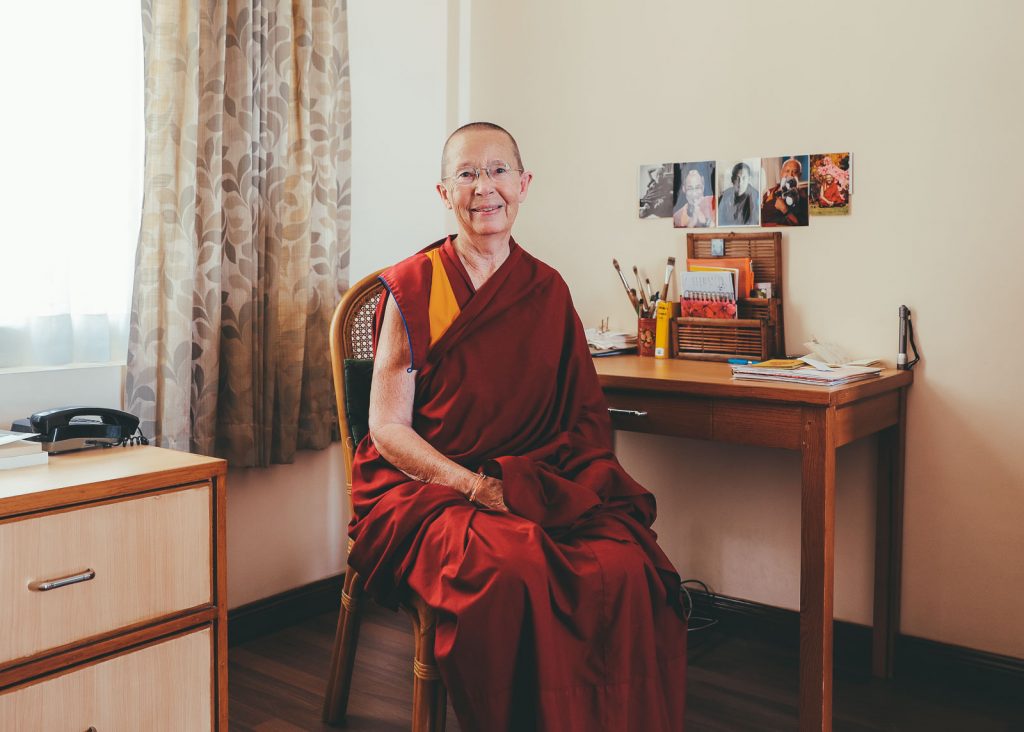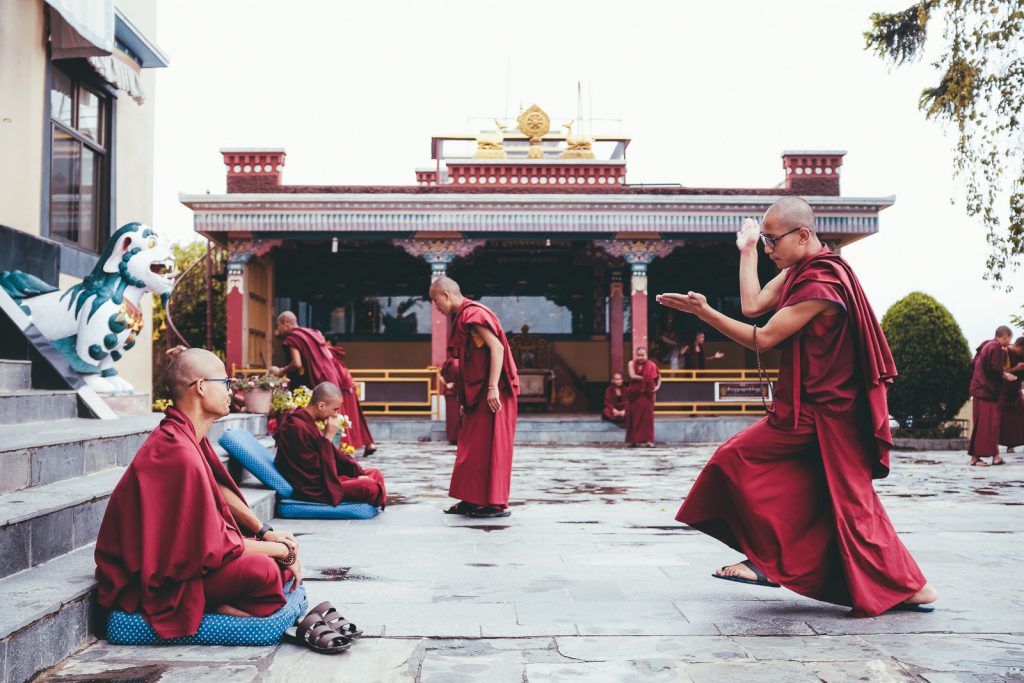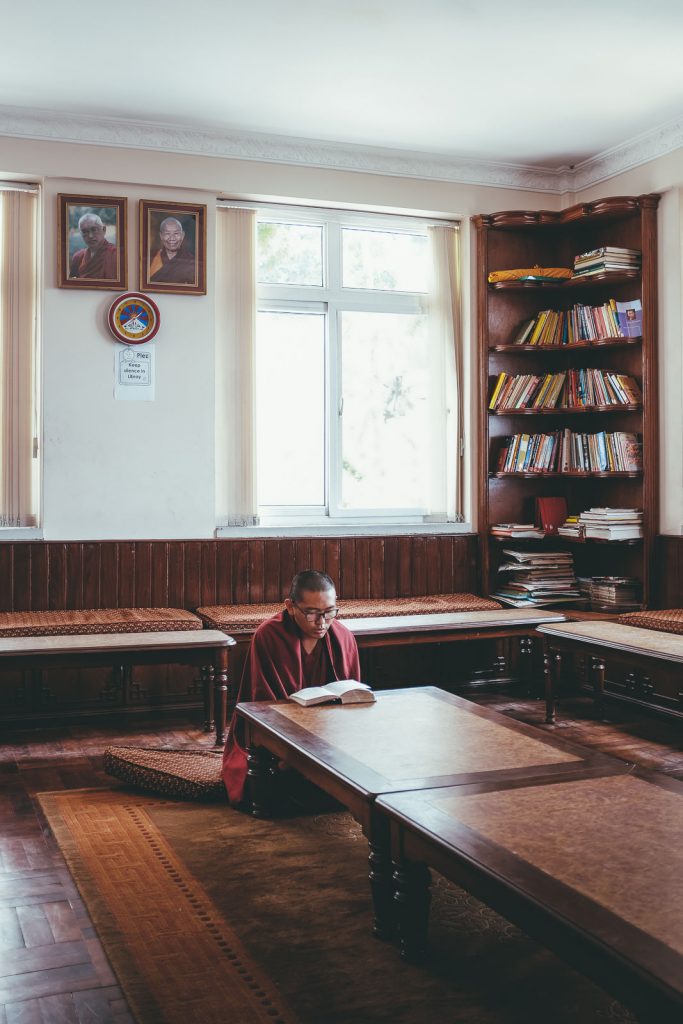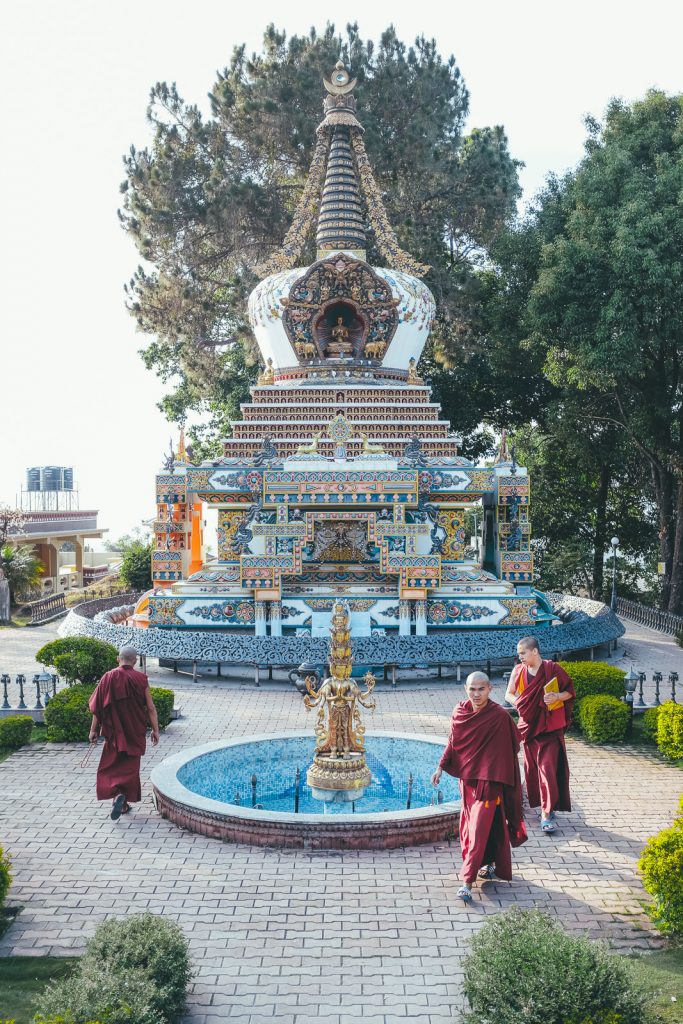
How a 24-year old Swedish girl became a Buddhist nun.
Story presented by the talented creator of @because.people.matter. Follow for more inspirational stories of humanity .
As a 13 year-old kid, I could totally lose myself in the story-telling capabilities of my history teacher. No one could tell stories like he did and as a result I often dreamt for days about the ancient Greek, the discoveries of Christopher Columbus or the Spanish civil war. He seemed to know everything about those times and when I carefully closed my eyes in the back of the room, it felt as if I was there. With him. With them. Unfortunately, it’s not often that you get to meet such people. People that inspire. People that move you. But when you do, you better make use of it and that’s the reason why I’d like to share Karin’s story with you. Because meeting her last month during our time in Kathmandu, Nepal, made me relive those golden days in High School all over again. Let me tell you why.

With Buddhist philosophy slowly making its way into the West, we decided to give it a try and signed up for an 11-day course called “Discovering Tibetan Buddhism” in Kopan Monastery, situated on a hill 30 minutes outside of Kathmandu. Amongst 150 like-minded people from all ages, all colours and all walks of life, we emerged ourselves in an extensive program to learn more about Buddhist philosophy and the power of our mind.

Spending time in a Buddhist monastery, far away from the buzz of our cities, the noise of our streets and the speed of our lives, can be a very healing thing.
Life in there is not dictated by the minutes, but by the rhythm of the cosmos and whereas speed mostly is the key indicator for life in the Western world, these shelters have turned slowness into a virtue. There’s no clocks, no alarm calls, no time. Rather, the days are guided by the setting and the rising of the sun, the morning puja and the serving of the soup.
Aside from daily meditations, we spend the first 8 days of the course learning about compassion, kindness and the power of our mind. We joined daily teaching by the monks about anger, affection, ignorance and faith. We sat down in discussion groups talking about things like karma, ethics, reincarnation and enlightenment. We had lots of occasional walks in the monastery gardens thinking about our universal existence and we contemplated with monks and nuns of all ages and backgrounds about how ‘they’ perceive reality. After those 8 days, we engaged in a 2-day silent retreat. No talking. No eye-contact. Just noble silence. A welcoming space to think and to slowly digest all new methods of generating happiness.
Our course leader for the entire 11 days surprisingly turned out to be a Swedish nun, Karin Valham. After traveling through Southeast Asia in the 1970s she stumbled upon an exquisite image of Shakyamuni Buddha in a photo shop near Freak Street, the well know hippie-haunt for travellers in Kathmandu. As a result she took a chance on a meditation course on the very same Kopan Hill, 30 minutes outside of the city. It turned out to be the ‘most wonderful experience’ of her life and she would become a nun just one year later. This is her story.

It was 1973 and being a daughter from Swedish protestants, I was on the way to becoming a social worker, just like everyone was at that time. I was serving as a nurse in a local hospital just outside of Stockholm and the amount of misery and suffering I encountered on a daily basis was unheard of. However, in some way I felt so extremely limited to help all those poor people. It felt as if there was something missing inside of me. So I decided to take a break to travel and to create space to think and hopefully return with more energy. I went to Asia. After making my way around Sri Lanka, India, Bangladesh, Thailand, Malaysia and Indonesia, I ended up in a cave among the hippies on Lamaro Beach in Darwin, Australia. It was mid seventies and everyone was happy. However, some money that my parents send over from Europe got stuck in a bank in India so I had to go back to Sweden to sort things out. My final destination on the way back home would be Nepal, a well trodden path back in that day.
“I ended up in a cave among the hippies on Lamaro Beach in Darwin, Australia. It was mid seventies and everyone was happy.”
After arriving in Kathmandu by bus from India, a local rickshaw driver took us to a little hostel right next to the large stupa in Thahity Chowk. The only room available was dirty with no shower but I kept it because of the stupa view. From the very beginning of my journey in Sri Lanka I always enjoyed the presence of Buddha images. The way they smile at everyone struck me, I guess.

The days that followed, I explored the many little shops around the square, went to the post office to pick-up and drop-off some postcards and airograms and passed by a photoshop to get some pictures taken. The chatty owner seemed to know all the comings and goings of the entire city and I hang out with him for a while until I discovered a large black and white photo of a Thankga painting on one of his walls. Again I got struck by the same Shakyamuni Buddha, his perfect body and his half-smile that revealed such an inner wisdom. It instantly reminded me of my time in Borobodur where I’d been multiple times during my time in Java, Indonesia. I simply couldn’t get enough of those Buddha carvings, although I had zero understanding of that whole so called ‘path to enlightenment’.
“I was just an ordinary Swedish girl that traveled the world and I knew I was destined to become a mother, to have a family and to grow old in Sweden.”
I asked the friendly owner of the shop where the photo was taken and he told me it was shot at ‘Kopan Monastery’, just outside Boudhanath and that they are frequently offering amazing meditation courses which I should definitely check out. Ever since I visited Wat U Mong Monastery in Chiang Mai, Thailand, I felt the desire to learn more about meditation so I decided to give it a try. If someone would have told me back then I was on my way to becoming a Buddhist nun, I would have laughed for a week. I was just an ordinary Swedish girl that traveled the world and I knew I was destined to become a mother, to have a family and to grow old in Sweden. Period.

It was November 1974 and together with Josef, my boyfriend at that time, we jumped on a bus to Boudhanath, walked up the steep hill and argued the entire way about the duration of the course. Josef was obviously more eager than I was and didn’t agree that the 30 days on-offer felt a little too long. My journey so far had taught me a lot, but I was starting to get tired of traveling and felt the need to put my life together, return to Sweden and do something more useful with my time. But I lost the battle and when we arrived at the gate, the guard told us the course had already started. All participants, mostly young travellers, were meditating in a large round tent. I immediately recognised a few of them from our nights in Freak Street where the joints were almost free and you got a hash cookie with every cup of coffee. I was amazed. Apparently there were more people drawn away by the whole idea of Buddha. But suddenly my attention got pulled away by the very same image I saw in the photoshop days earlier. But this time in full color, 3 times as big in size, right in front of the tent. I couldn’t keep my eyes away from it for the rest of the meditation.
“All participants, mostly young travellers, were meditating in a large round tent. I immediately recognised a few of them from our nights in Freak Street where the joints were almost free and you got a hash cookie with every cup of coffee”
We were accommodated on the second floor of the monks’ quarter.
Receiving visitors was relatively new for the Monastery so they moved all monks into one part of the building and opened up the other space for us. I shared a room with two other girls, sleeping on the floor on straw mats. My possessions back then were reduced to what could fit into a small Australian school bag and we didn’t have bedding or towels. The nights were freezing at 1450m altitude but since Josef had given me his only blanket, he used to sneak in to sleep next to me to keep each other warm.
Despite the conditions,
the mediation course itself was amazing. We got daily teachings by the older monks, who’s sincerity, purity of mind and genuine way of life, really hit me. Especially those of Lama Zopa Rinpoche and Lama Yeshe, two amazing human beings and founders of the Monastery. We simply had so much fun together and it seemed like they diffused any potential problem in life with practising Dharma. Their stories about Karma made so much sense and although I was sitting in the back of the tent, it felt as if they were specifically talking to me by addressing my personal issues and explaining me how to deal with them. In some way, their love and kindness made me believe in myself and in my own potential to change my life. They even succeeded in making the more profound topics like ‘the fantasy projection of our dualistic mind’ or ‘the theory of impermanence and reincarnation’ sound like common-sense. I found what I was looking for, the Dharma and towards the end of the course I decided to stay and attend another one-month meditation retreat. Although Josef took off and I only had a little bit of money left, I felt as if I started a new chapter in my life.
Together with a few other Western people we decided to stay and form our own little community and very soon Kopan started to feel like home, my spiritual home. I felt such a strong sense of belonging here and for the very first time I realised that perhaps I was destined, I was supposed to become a Buddhist nun. But on the other side, we were just a bunch of Western hippies guided by a few young Tibetan Lamas. All we did was practising the dharma while having fun. Lots of fun. But after a while it was time to go home, speak up and ask my parents for approval. They were shocked, of course. Which parents wouldn’t be? But they were very nice people and I’m sure they knew me better than I did. When I think about that now, I certainly wouldn’t allow my daughter to follow the same path, haha. But they weren’t like that. They were very intuitive people. I think they just trusted me and our relationship which gave me the freedom to live my life.

So I went back to Nepal and kept on writing letters with them because staying home and continuing my study wasn’t an option. In Sweden I felt like a sore thumb sticking out, a weirdo with a shaved head, wearing red robes. Nobody was waiting for that which made me feel lonely and unaccepted. In Sweden back then, there simply was no space for Buddhist nuns so I left. In the 5 years that followed my father decided to support me financially, which made life definitely easier because it made me able to travel around the world to extend my knowledge about the Dharma. I studied in Dharamsala in India and went to Australia for 2,5 years. I even brought my teachers to Sweden one time to show them where I was born. But wherever I traveled I always felt home-sick for Nepal. In those years I literally cried when I had to leave Kopan and I counted the days to come back.
“In Sweden I felt like a sore thumb sticking out, a weirdo with a shaved head, wearing red robes.”
Over time, my teachers became my best friends, in a way I can’t really compare with best friends back home. There’s such a deep connection between you and your teacher. When you spend so many years meditating together, there’s some magic happening on a deeper level. And their degree of honesty was also totally new to me, there’s no hidden agendas and you can count on them for your whole life. Whatever happens, they will never ever abandon you. It’s like they have a ring of love and compassion and when you hook on to that ring, they will never let you go and they pull you up and up and up whenever you need it.
And when looking back, it wasn’t always easy. Turning 40 for instance, usually is a big decision point in the life of Western monks and nuns. Almost all of them disrobe around that age which means they hand in their robes and move back to an ordinary life. Some of them feel like they should have a husband or wife at that age. I guess there’s a mid-life crisis for everyone haha, also for monks & nuns. But moving back is not an easy thing to do because in the West you’re not taken seriously without a proper degree. Here you just get a ‘diploma’ after 12 years of Higher Studies but when you tell someone in Europe you spend 30/40 years in a monastery and show them that diploma, they think you’re a total weirdo. So most of them are going back to university at the age of 40 in order to get a ‘Western’ degree in Buddhist philosophy to be able to continue practising the Dharma back home and become a teacher in the Western world. It’s not easy. But fortunately I never had that struggle.
“I guess there’s a mid-life crisis for everyone haha, also for monks & nuns”
Sigh. It’s been a journey. My life changed completely and it’s not recognisable in any way whatsoever. But I don’t like to look back. You know, when living here, you have to totally forget about the ordinary life you had before. I have been in Kopan for 44 years now and people sometimes ask me if I would do it all over again? The answer is yes, every single minute of it. As a course leader, I’m feeling so privileged to be play a crucial role in getting other people interested in the Buddhist lifestyle and the dharma teachings. But it’s important to realise hat I’m only a kindergarten teacher compared to the knowledge, wisdom and compassion of my own teachers.
And well, as far as I understand happiness, I think I’m happy. Well, I’m content, let’s put it that way. It’s a dream to live here and I’ll continue until I drop off the pin.

After having spend 11 days with Karin and listening to her story about the true meaning of life, I’m slowly starting to understand why people argue that the Buddhist philosophy probably is the most intelligent thing this benighted planet has come up with. It’s been a life-changing experience to witness first-hand how you can change your ‘own’ life and that of others by simply changing the way you look at things. But it’s not easy in the society we nowadays operate in. Therefore I’d like to leave you with a few questions. Questions that have been running around my head for a while. Just think about them, share them with your friends and see if they make you think about the way you live your ‘own’ life:
- What if we stopped celebrating being busy and overextended as a measurement of importance? What if instead we celebrated how much time we had spent listening, playing, thinking, meditating and enjoying time with the people we love?
- What if the only expectations that mattered were our own?
- What if society would stop telling us to buy stuff we don’t need, with money we don’t have, to impress people we don’t like, and instead encourage us to create more space to breathe and think?
- When was the last time you simply sat down to think? And when was the last time you were actually bored? What if we switch off our phones and laptops a little more and instead turn on the full power of our minds?
- What if everyone around you would spend a little more time taking care of their mental health instead of spending countless hours maintaining their physical appearance? Wouldn’t that make the world a more peaceful place?
- What if our schools allowed students more time to think about their highest possible contribution to society instead of getting them ready for a rat-race to nowhere?
- What if we would have fewer things and fewer thoughts? Wouldn’t there be much more space for appreciation then?
All of the above are just a matter of everyday choices. Choices I can make, choices you can make, choices Karin has made, choices everyone can make. And especially in times when the abundance of ‘choice’ is bigger than it ever was in the history of mankind, I believe it’s important to make the right ones. Because taking care of yourself means you’ll be able to take more care of your environment too. Our planet needs us.
If you wanna know more about this special course feel free to check the website of Kopan Monastery. They offer amazing courses all-year round on various entry levels and I promise you, it will blow your mind. I strongly recommend you to consider taking a few weeks of your valuable time and travel to Nepal to experience first-hand how your mind ‘really’ works and how changing your own behaviour and the way you look at the world, can have such a significant impact on your own happiness and on that of others.

Feel free to comment below and let us know what you thought of this post! You can find more of @pie_aerts’s work RIGHT HERE on his blog. His work is incredible! Thank you for reading.

